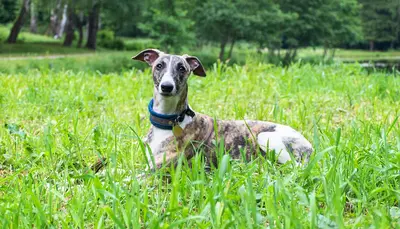Labradoodle: Breed Guide
- 21 Dec 2019
- 12m read

Meet the affectionate and sociable Labradoodle. If someone did a study, we're pretty sure they'd be named one of the nicest-natured animals on the planet.
Labradoodle Origin
What happens when you cross a Labrador with a Poodle? A Labradoodle. No joke or pun intended here, just the product of two legendary breeds brought together.
This charming crossbreed was initially bred in the late 1980s in Australia, primarily with the intention of creating a guide dog suitable for individuals with allergies to pet dander.
The story goes that Wally Conron, an Australian breeder, received a request from a blind woman in Hawaii who needed a guide dog that wouldn't trigger her husband's allergies. To meet this unique requirement, Conron crossed a Standard Poodle with a Labrador Retriever, combining the intelligence and hypoallergenic coat of the Poodle with the friendly and trainable nature of the Labrador.
The result was the Labradoodle, a crossbreed that quickly gained popularity for its appealing traits. Labradoodles are known for being friendly, intelligent, and somewhat hypoallergenic, making them suitable for families and individuals with various needs.
What Were Labradoodles Bred For?
Labradoodles (or "Doodles" for short) were initially bred as assistance dogs, combining the intelligent and biddable nature of the Lab with the minimal hair shedding of a Poodle.
Today, they're still found working as assistance and therapy dogs, as well as being much-loved family members. And they've got a funny name, as an added bonus.
Labradoodle Breed Group
According to the The Kennel Club UK guidelines, Labradoodles are classified as crossbreed dogs. As a crossbreed, they result from the intentional combination of a Labrador and a Poodle. Crossbreeds aren't assigned specific breed standards or recognised pedigrees by traditional kennel clubs.
What is an Australian Labradoodle?
G’day mate. You wouldn’t be alone if you thought that the logical answer to this question is simply a Labradoodle bred in Australia.
However, the actual answer is a little more complicated. A sure fire way to stump everyone at the pub quiz. A dog themed pub quiz…yes please.
Back to business. According to The Labrador Site, whilst the humble Labradoodle is bred from one Labrador parent and one Poodle parent, Australian Labradoodles can be a mix of up to six different breeds. These include: Labrador, Poodle, Cocker Spaniel, American Cocker Spaniel, Curly Coated Retriever, Irish Water Spaniel.
These breeds are selectively mixed together with the end goal of producing a pooch with all of the best qualities from each breed. It is believed that there is much more consistency in Australian Labradoodles, in terms of appearance, size and temperament, due to 35 years of selective breeding.
Labradoodle Ideal Owner
The Labradoodle, with its friendly nature and intelligence, makes an ideal companion for someone with an active lifestyle and a commitment to positive reinforcement training. This breed thrives on social interaction and being part of the family, requiring regular outdoor activities and affectionate care.
Labradoodle owners should be prepared for regular grooming due to their coat characteristics, and those with allergy considerations may appreciate the hypoallergenic qualities of the breed.
Labradoodle Size
The great unanswerable question. Truth is, it’s really hard to know exactly what size a Labradoodle will be when he or she is fully grown. Looking at the parents is a great starting point but knowing who they’ll take after is anyone's guess.
How Big Do Labradoodles Get?
According to Labrador Training HQ, fully-grown male Labradoodles will usually grow to be somewhere between 22 and 24 inches tall. Females, on the other hand, will sit at around 21 and 23 inches tall.
This is taking into account a Labradoodle bred from a standard-size Labrador and Poodle, if your Labradoodle is bred from a smaller Labrador and Miniature or Toy Poodle then the resulting pups will be much smaller. Miniature Labradoodles are estimated to grow to be between 14 and 16 inches tall.
How Much Should a Labradoodle Weigh?
According to Labrador Training HQ, fully-grown Labradoodles will typically weigh 50- 65 pounds, whilst miniature Labradoodles will weigh somewhere between 15-25 pounds.
When Do Labradoodles Stop Growing?
Labradoodles typically reach their full height by around 12 to 16 months of age, but their growth in terms of weight and muscle development may continue until they are about 18 months to 2 years old.
The rate of growth can vary among individual dogs, and factors such as genetics, nutrition, and overall health play a role in determining their growth pattern.
Labradoodle Coat
The Labradoodle's coat is one of its most distinctive features, and it can exhibit a variety of colors and textures, showcasing the influence of both the Labrador Retriever and Poodle parent breeds. The coat colors range widely and can include shades such as cream, chocolate, black, apricot, red, and more. Additionally, Labradoodles may have solid coloUrs or various combinations and patterns.
In terms of texture, Labradoodle coats can vary as well. They often inherit the Poodle's curly or wavy hair, which can be more hypoallergenic and low-shedding. However, some Labradoodles may have a straighter coat reminiscent of the Labrador Retriever. The unique combination of these characteristics makes each Labradoodle individual, and grooming requirements can differ based on coat type.
Do Labradoodles Shed?
As a single-coated breed, Labradoodles are not affected by seasonal shedding but can be prone to general shedding as a result of their Labrador ancestry.
Are Labradoodles Hypoallergenic?
Again, due to their parental variation, it is hard to say whether or not a Labradoodles will be hypoallergenic.
The Poodle, known for its curly or wavy coat, tends to produce less dander and shed less than some other breeds. Dander, which consists of tiny, even microscopic, flecks of skin shed by cats, dogs, and other animals with fur or feathers, is a common allergen.
However, it's important to note that the degree of hypoallergenicity can vary among individual Labradoodles. Some Labradoodles may have a coat that is more similar to the straighter, shedding coat of the Labrador Retriever parent, and this may produce more dander.
It’s useful to note that no dog breed is considered 100% hypoallergenic, whilst some breeds are regarded as non-shedding, they will still produce dander (dead skin cells) which can also trigger allergy symptoms.
How to Groom a Labradoodle
Labradoodles need thorough grooming to keep those glamorous ringlets in check, but they also just simply appreciate a spot of pampering.
It is recommended that a Labradoodle is fully groomed every six to eight weeks to prevent matting and tangling. This involves bathing, clipping (hair, nails) and brushing. Whether this is done professionally by a groomer or by you or is your choice. Many people opt for the former to make life easier but this isn’t always an option.
Ideally, you should be light-brushing your Labradoodle every few days to make the bigger groom a lot easier. If you happen to miss a few key brushing sessions and find that your pooch has developed some tough tangles, using specialised dog-detangler spray can help to tease them out more easily.
Labradoodle Personality
Understanding the unique personality traits of Labradoodles is key to developing a strong and loving connection with them.
Are Labradoodles Good Family Dogs?
Yes, Labradoodles are good family dogs.
Labradoodles are bred using two of the most well-known, affectionate breeds, the lovely Labrador and the Pawsome Poodle. Their high energy and playful nature makes them a great addition to any family. They are one of few breeds recommended for first-time dog owners, due to being easy(ish) to train.
As with all dogs, you should be mindful of introducing dogs into homes with young children. Early socialisation will help to make sure that both sides are comfortable, eventually forming a bond that 007 himself couldn't break.
Doodles (still funny) thrive on company, exercise and play and are a great choice if you fancy trying your hand at agility.
Are Labradoodles Easy to Train?
Yes, Labradoodles are easy to train.
Labradors, one of the parent breeds, are renowned for their trainability and friendly nature, while Poodles are highly intelligent and often excel in obedience training. The combination of these traits in Labradoodles makes them quick learners and adaptable to various training exercises.
Do Labradoodles Bark A Lot?
Generally, Labradoodles are not known to be excessive barkers.
Both the Labrador Retriever and Poodle parent breeds are typically friendly and sociable, and Labradoodles often inherit these traits.
However, it's crucial to note that any dog's behaviour, including barking, can be shaped by their environment and upbringing. Proper socialization, positive training methods, and providing mental and physical stimulation can help prevent or manage excessive barking.
Are Labradoodles Intelligent?
Yes, Labradoodles are intelligent.
This breed is a cross between the Labrador Retriever and the Poodle, both of which are highly intelligent breeds. Labradoodles tend to inherit the intelligence and trainability from their parent breeds, making them quick learners and adaptable to various training activities.
It's important for Labradoodle owners to provide consistent training, positive reinforcement, and mental enrichment to keep their intelligent minds active and satisfied. They often excel in obedience training and enjoy engaging in mental stimulation activities.
Can Labradoodles Be Left Alone?
Labradoodles, like many dog breeds, are social animals that generally prefer the company of their human family. Leaving them alone for extended periods can lead to feelings of loneliness or anxiety. However, Labradoodles are known for their adaptability, and with proper training and gradual acclimation, they can learn to be alone for reasonable durations.
Can Labradoodles Swim?
Yes, Labradoodles can swim.
Both parent breeds, the Labrador Retriever and the Poodle, are known for their love of water and swimming. Labradoodles often inherit this trait and can be natural swimmers.
However, as with any dog, individual temperament and comfort level with water may vary. Some Labradoodles may take to swimming enthusiastically, while others may need a bit of encouragement or gradual introduction to water.
Labradoodle Exercise
Labradoodles are known for their energy and enthusiasm, and their exercise needs can vary based on factors such as age, individual temperament, and overall health.
How Much Exercise Do Labradoodles Need?
As a general guideline, adult Labradoodles typically benefit from at least 60 minutes of exercise per day. This can include activities such as brisk walks, jogging, playtime in the garden, or interactive games.
Puppies and younger Labradoodles may have higher energy levels and may require more frequent, shorter bursts of exercise to help them burn off excess energy.
For elderly Labradoodles, the fireside appeals more than the park, and your enthusiastic "walkies” voice might fall on (purposefully) deaf ears. Nevertheless, gentle exercise each day is important to prevent elderly limbs from becoming stiff, as well as helping to maintain a healthy weight.
Additionally, mental stimulation is essential for Labradoodles due to their high intelligence. Engaging in activities that challenge their minds, such as puzzle toys, training sessions, or interactive play, can contribute to their overall well-being.
Labradoodle Health
Labradoodles, like any breed, can be prone to certain health conditions.
Are Labradoodles Prone to Any Health Conditions?
Rather ironically, Doodles are often bred to be hypoallergenic to humans but are prone to allergies themselves.
Some Doodle skin is sensitive to dust mites, pollen, household chemicals or insect bites. You can get a soothing topical ointment from the vet and will need to be sure you bathe your Doodle using only gentle shampoos. You can also help their skin by feeding them the right diet. The beta carotene in some vegetables, as well as natural oils and fats, can help to care for their skin and curly coats.
Skin complaints can also come about because of food sensitivities. Certain foods are known to cause allergic reactions in some dogs, and some of these allergens are common across species. Like us, dogs can be intolerant of wheat. All Butternut Box recipes are free of most potential allergy-inducing ingredients.
Labradoodle Cost
First and foremost, you should ensure that you’re buying your pup from a reputable breeder or rescue centre. This will help to ensure that your dog has been bred and cared for in the right circumstances.
A sound woof of advice from us, if it seems too good to be true it’s likely that it is. A dog is a huge investment in time, money and love, so make sure that you take the time to do plenty of research before making any decisions.
How Much Do Labradoodles Cost?
According to research conducted by Pets4Homes UK as of 2022, the average cost of purchasing a Labradoodle is £1,381.
As well as the cost to purchase a Labrador, it’s important to be mindful of the other expenses involved when bringing a pooch into your life. Such as:
• Vaccines, flea & worming treatments (including initial and yearly booster vaccines)
• Neutering or spaying
• Equipment (collar, harness, lead, bed, bowls, brushes, washes, toys, poo bags)
• Food
• Insurance
• Daycare and boarding
Labradoodle Feeding
The eating habits of a Labradoodle is really hard to predict. One one hand, Labradors will eat almost anything they can get their paws on. Whilst Poodles are renowned for turning their noses up. Depending which parent your Labradoodle takes after, they could be the ultimate foodie or the the ultimate fusspot.
At Butternut Box, we have 12 different recipes, including a veggie and plant-based option if that's your pooch's preference. When you sign up to Butternut Box, we ask you a few questions about your dog, such as their breed, age, weight and activity level. This helps our super-clever algorithm to work out exactly how much food your dog needs to maintain a healthy weight. It even takes into account treats, so you can continue to reward your precious pup. This makes feeding your Doodle an absolute doddle. Doodle…doddle.
To get an exact price and plan, click the Build Your Box button.




